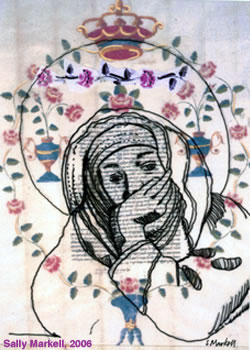| |
 Saint
Catherine of Siena Saint
Catherine of Siena
by Judy A. Johnson
Portrait
of Catherine of Siena by Sally
Markell
I am an introvert. I live with two cats in a one-bedroom apartment. I see it
as place where I can focus and grow spiritually. For me, it is the environment
where I feel closest to God. But life is not that simple. We are called to
model Jesus’s beloved friend Martha—the doer, the people-person,
the one who knew how to take care of others—as well as her sister—the
quiet, listening Mary. 
For
people like me, who have struggled all our lives to blend a call
to action with a yearning for contemplation, Saint Catherine
of Siena balances contemplative and active life in a way that inspires both
envy and admiration.
It’s
tempting to divide Catherine’s life
into two distinct periods, the first contemplative and the second active.
The youngest of 24 children, Catherine
began having visions and mystical experiences at age seven. She dedicated
her life to God, vowing perpetual virginity, even cutting off
her hair to make
herself less attractive when she was a marriageable adolescent. She wanted
to become
a Third Order Dominican, a lay position that would still bind her to vows
of poverty, obedience, and celibacy. Although living outside
the convent, Third
Order members could wear the Dominican habit. Her parents opposed this request
for a time; ultimately, her father gave her “a room of her own,” in
which she could remain, fasting and praying. There Jesus came to meet her
daily; among other gifts, he taught her to read.
The
pivotal event in Catherine’s
life came after three years of solitude and ascetic practices. Jesus
stood in the doorway of her room, but instead of
entering as she invited, he told her, “You must come out here now.” She
apparently didn’t question Jesus, but began serving others in Siena,
visiting prisons and nursing plague victims. Eating, which had never been
very important
to her, nearly stopped altogether; according to legend, she lived on the
communion wafer and a bit of water for the last nine years of her life.
Catherine
actively
pursued the work of making peace among the rival families of Italy and
within the Roman Catholic Church, fractured by the pope’s
move to Avignon, France. In 1376, convinced that Pope Gregory
XI, who had been living in Avignon,
needed
to come back to Italy, Catherine and her followers (whom she called her “family”)
walked to France. There she reminded the Pope of a vow he’d made,
but which he’d never revealed. Catherine’s prophetic gifts
stunned and persuaded Gregory; he returned to Italy. Catherine also supported
the
idea of another crusade
and tried to make peace in the face of the Great Schism under Gegory’s
successor, Urban VI.
Although
this neat division of Catherine’s
life into early contemplative and later active segments is tempting,
it’s also misleading. In her early
years, Catherine was a daughter in a busy home, helping with domestic
duties and nursing the sick during outbreaks of the plague. During
her later, more outward
ministry, she sometimes entered a trance in the middle of a conversation.
She also received the stigmata, the marks of Christ’s passion,
on her body, though until her death they were visible only to her.
While
carrying on this active ministry, Catherine wrote or dictated some
400 private letters and one major work, The Dialogue, which has
been
compared to
Dante’s work. This conversation between the soul and God is sprinkled
with spontaneous declarations of love for God and quotations from Scripture
woven
seamlessly into her own speech patterns.
Reading
The Dialogue for a medieval church history class in
seminary, I was immediately attracted to the opening
words,
A
soul rises up, restless with tremendous desire for God’s honor and the salvation
of souls. She has for some time exercised herself in virtue and has become
accustomed to dwelling in the cell
of self-knowledge in order to know better God’s goodness
toward her, since upon knowledge follows love. And loving, she
seeks to pursue truth
and clothe
herself in it.
I
loved that image of the nun’s or monk’s
cell as a place of self-knowledge. I’d
long wondered how Catherine could bear to leave her cozy cell, where
she and Jesus spent a thousand
days together. I’ve
come to realize that the cell of self-knowledge isn’t confined to
a literal place with four walls, as is an enclosed contemplative’s
cell. Catherine could walk beyond her cell’s threshold because
she had learned who she was and what her work was to be. She recognized,
too,
that it was Jesus standing at the lintel; I think
she must have seen Jesus in every face she looked at ever after.
I
too have walked out a bit. Though by attending seminary, I wasn’t
looking for a change in my service or personality, my post-seminary years
have offered
new opportunities for a more unexpectedly active life than I ever would
have predicted: a teaching ministry among the vibrant young people of my
church; opportunities
to companion those in pain; and a book in print at last, with the ministries
that publication can offer.
Catherine
lived out the questions of the Book of Common Prayer’s
baptismal covenant: “Will you seek and serve Christ in all
persons, loving your neighbor as yourself? Will you strive for justice
and peace among all people, and respect the dignity of every human
being?” The expected response is, “I will, with God’s
help.” Catherine offers contemporary seekers a powerful example
of blending contemplation with action.
©2006
Judy A. Johnson |




